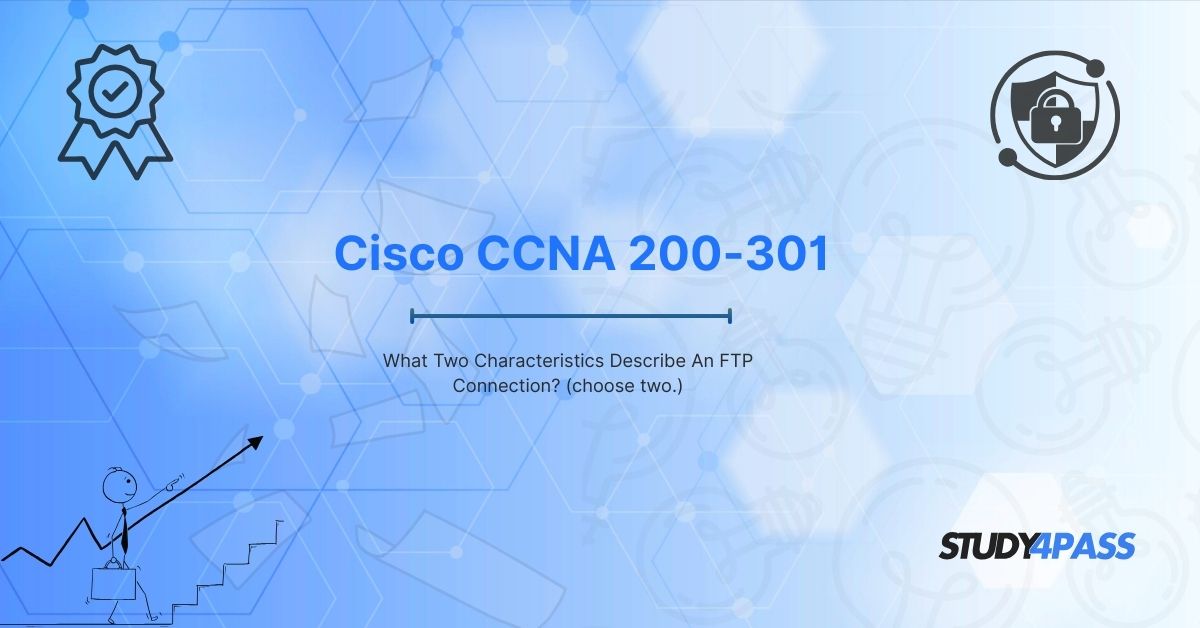Introduction
The File Transfer Protocol (FTP) is a standard network protocol used for transferring files between a client and a server over a TCP/IP network. As part of the Cisco CCNA 200-301 certification, understanding FTP is crucial for network configuration and troubleshooting.
In this comprehensive guide, we will explore the two key characteristics that describe an FTP connection, along with its working mechanism, security concerns, and practical applications. Additionally, we will highlight how Study4Pass can help you master CCNA 200-301 concepts effectively.
Understanding FTP (File Transfer Protocol)
Definition and Purpose
FTP is one of the oldest and most widely used protocols for transferring files between systems. It operates on the Application Layer of the OSI model and relies on TCP (Transmission Control Protocol) for reliable data delivery.
FTP vs. Other File Transfer Protocols
While FTP is efficient, it lacks built-in encryption, making SFTP (SSH File Transfer Protocol) and FTPS (FTP Secure) more secure alternatives. However, FTP remains relevant in many legacy systems and internal networks where security is less of a concern.
Two Key Characteristics of an FTP Connection
1. FTP Uses Two Separate TCP Connections
One of the defining features of FTP is that it uses two separate TCP connections for communication:
A. Control Connection (Port 21)
- Used for sending commands and responses between the client and server.
- Remains open throughout the FTP session.
- Handles authentication and directory navigation.
B. Data Connection (Port 20)
- Used exclusively for transferring files.
- Opens only when a file transfer is initiated and closes afterward.
- Can operate in Active or Passive mode.
2. FTP Operates in Active and Passive Modes
FTP supports two different modes of operation to handle firewall and NAT traversal:
A. Active Mode FTP
- The server initiates the data connection back to the client.
- Client opens a random port (>1023) for data transfer.
- Server connects from Port 20 to the client’s specified port.
- Disadvantage: May fail if the client’s firewall blocks incoming connections.
B. Passive Mode FTP
- The client initiates both control and data connections.
- Server provides a random port for data transfer.
- Better for clients behind firewalls.
- Disadvantage: Requires the server to allow multiple open ports.
How FTP Works: Step-by-Step Process?
- Connection Establishment
- Client connects to the server’s Port 21 (Control Connection).
- Authentication occurs (username/password).
- Client sends a command (e.g., RETR for download, STOR for upload).
- In Active Mode, the server connects to the client’s data port.
- In Passive Mode, the client connects to the server’s data port.
- Files are transmitted over the Data Connection (Port 20 or a random port in Passive Mode).
- Data connection closes after transfer.
- Control connection remains open until the session ends.
Security Concerns with FTP
Lack of Encryption
- FTP transmits data (including credentials) in plaintext, making it vulnerable to eavesdropping.
Mitigating FTP Security Risks
- Use SFTP (SSH-based) or FTPS (SSL/TLS-based) for encrypted transfers.
- Implement VPNs for secure remote file transfers.
5. Practical Applications of FTP in Networking
- Network Device Backups: Routers and switches can export configurations via FTP.
- Software Distribution: Large files (e.g., firmware updates) are often hosted on FTP servers.
Why Study4Pass is the Best Resource for CCNA 200-301 Preparation?
Preparing for the Cisco CCNA 200-301 exam requires reliable study materials and hands-on practice. Study4Pass provides:
Comprehensive Study Guides – Detailed explanations of networking concepts, including FTP.
Real-World Practice Exams – Simulate the actual CCNA exam environment.
Expert-Led Training – Learn from certified professionals with industry experience.
By using Study4Pass, you gain access to structured learning paths that help you master FTP, TCP/IP, subnetting, and other critical CCNA topics efficiently.
Conclusion
FTP remains a fundamental protocol for file transfers, characterized by:
- Two separate TCP connections (Control + Data).
- Support for Active and Passive modes.
Understanding these concepts is essential for the Cisco CCNA 200-301 exam and real-world networking. For the best preparation, leverage Study4Pass’s expert resources to ensure success in your certification journey.
Final Words
Mastering FTP and other networking protocols is easier with the right study tools. Visit Study4Pass today to access premium CCNA 200-301 training materials and boost your IT career!
Special Discount: Offer Valid For Limited Time “200-301 Exam Prep Practice Test”
Sample Questions for Cisco 200-301 Exam Prep Practice Tests
Actual exam questions from Cisco's 200-301 Exam
1. Which two characteristics describe an FTP connection? (Choose two.)
a) Uses a single TCP port for control and data
b) Requires encryption for all transmissions
c) Establishes two parallel connections (control and data)
d) Relies on UDP for faster transfers
2. FTP connections are known for which two features?
a) Using only one connection for all operations
b) Separate control and data connections
c) Operating exclusively over UDP
d) Supporting anonymous logins
3. What are two key aspects of an FTP connection?
a) Uses port 21 for control commands
b) Transfers data exclusively in encrypted form
c) Establishes a separate data connection (usually port 20 for active mode)
d) Works only within a local network
4. Which two statements are true about FTP connections?
a) FTP sends control commands over a persistent UDP connection.
b) FTP uses two separate TCP connections (control and data).
c) FTP does not require authentication for any transfers.
d) FTP allows both active and passive transfer modes.
5. Identify two correct characteristics of FTP:
a) Data and control traffic use the same port.
b) Control connection is maintained on TCP port 21.
c) FTP is a peer-to-peer protocol without a client-server model.
d) Data connection can be established dynamically.


